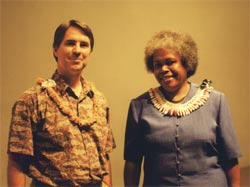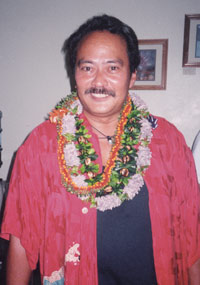|
While Wilson warns against too much optimism about the
local, he also is optimistic enough to suggest that the
relation between the global and the local can create
"third spaces" of interaction which can
intervene against the uneven spread of capital that
globalization causes. He urges: "We can begin
articulating a ’critical regionalism’ in the
Asia-Pacific region, respectful of Asian and Pacific
heritages, diasporas, and communities but wary of
hegemonic designs on these diverse localities and
groupings, as well as begin interlinking globally these
local struggles" (50). This call for global
interlinking is one that is especially valuable. (David
Harvey urges similarly in Spaces of Hope which came
out this year also.) And especially resonant as concerns
local poetries.

Geoff White (Director of the East-West Center at the
University) of Hawai’i; Grace Molisa, (writer from
Vanuatu)
Poets in the United States have since the 1950s gathered
themselves into a series of locally grounded collectives
that reflect various specific cultural, political, and
aesthetic concerns. Hawai’i is lucky enough to have
two thriving scenes serving its population of less than a
million right now: an Asian-American scene (mainly
centered around the press Bamboo Ridge) and a Hawaiian
scene (which is just establishing itself as centered
around the journal ’Oiwi). (A third scene that
is cross-ethnically identified is emerging in journals
such as Hybolics and Tinfish). The
fracturing of United States poetry scenes has become even
more intense as governmental support has decreased. Many
writing collectives, for instance, have avoided (or found
it too trying or impossible to create) larger alliances
and audiences. So a call for global interlinking among
local scenes seems very necessary if one believes, as I
do, that these literatures can be a part of building other
worlds, other political models, other social
arrangements.

Laura Lyons
(University of Hawai’i, Manoa, faculty member)
Yet this interlinking might be more difficult than Wilson
suggests. My one critique of Reimagining the American
Pacific is that it skips too quickly over some of the
controversies that have haunted the local literary scene
in recent years. The community discussion, and at moment
protest, about racism that surrounded Lois-Ann
Yamanaka’s Blu’s Hanging gets a mere
footnote (despite there being a chapter on Yamanaka’s
work). And similarly, the critique by some local writers
that the Asian-American Bamboo Ridge has been guilty of
neo-colonial privilege as it has not published any
literature written by Hawaiians (Kanaka Maoli) could use
some more attention. The localism, for instance, of many
Bamboo Ridge authors has been criticised as yet another
Micheneresque move by settlers to profit from and make
claims on Hawai’i. Yet many Bamboo Ridge writers
turned to their form of localism in resistance to writing
by figures such as James Michener, James Jones, Jack
London, and other figures. Wilson also barely addresses
the unique influence that the sovereignty movement has had
both in terms of creating an audience for and shaping the
content and aesthetics of Hawaiian literature (or to the
relation between Bamboo Ridge’s avoidance of
sovereignty issues and their adherence to a fairly limited
aesthetic). Hawai’i, in other words, remains, and will
probably always remain, a uniquely contested space. But
once one addresses these contestations, Wilson’s
suggestion of alliance seems almost impossible among
Hawai’i’s local literary scenes right now (despite
journals like Hybolics’ and
Tinfish’s attempts). While the details of the push
and pull between race, colonialism, and neo-colonialism
are unique to Hawai’i, the distinctiveness and often
contradictory goals of various issues in local and
specific literatures makes interlinking difficult. Wilson
knows all this. And his model of how the local is shaped
by the global (and vice versa) suggests new possible
interlinked models even as it leaves out the specifics. At
the end of his preface, Wilson states that
"Hawai’i needs some different strategies and
newer tactics of symbol making, needs a broader or more
global vision of the local plight (’plight of the
local’) as it were" (xviii). The manifesto of
different strategies and newer tactics is what is missing
from this book.

Hawaiian writer Darryl Keola Cabacungan
Instead of prescribing a future for Hawai’i’s
local literary scenes, Wilson turns to the new symbol
making that he himself did upon arrival in Hawai’i. In
the ending of Reimagining the American Pacific, he
tells his story of arriving in Hawai’i with his
Italian/Scottish identity. He suggests that his arrival in
Hawai’i is "a way across and out of American
common sense" rather than being another example of
Manifest Destiny (274). At one moment in this chapter he
asks, "what kind of new ’pidgin cuisine’
identity-speak was I cooking up here - part Italian, part
Taiwanese, part Korean, part Hawaiian" (280). This
assertion of alliance with the local is one that has
caused the most consternation among some fellow
island-dwelling-mainland-haoles that have read
Wilson’s book. Recently, when I was talking to a
colleague’s creative writing class, she told me the
class had just finished reading Reimagining the
American Pacific and asked me what I thought of
Wilson’s claim that he was a local writer (a claim
which I admit I do not really see him making that
explicitly). I said I could see both arguments. I could
see an argument that a haole should never suggest (even in
a question) that one could become local in an occupied
land. And yet I also saw a usefulness in the claim
(provided it was a claim that was at the same time
anti-colonial - which Wilson’s is) as it suggests that
the more recent residents of Hawai’i have
responsibilities to and are part of Hawai’i’s bad
history. At that moment I realized that I was willing in
this instance to read Wilson’s question positively. If
there is any place in the United States that the discourse
of celebratory hybridity appears most false, it is in
Hawai’i where one can never forget that one lives in
stolen land and that the hybridity of Hawai’i has not
necessarily been an equal choice for everyone. (It is not
that the rest of the U.S. is not stolen; just that there
aren’t as many reminders.) And yet Wilson’s desire
for an anti-colonial mongrelism might be one way to
negotiate between two contradictory realities of
Hawai’i: the mixing of its cultures and the separate
rights of its indigenous peoples.
|
